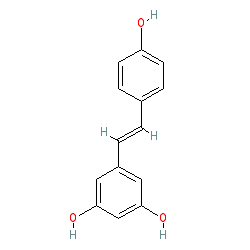|
Synonyms: 3,4',5-stilbenetriol | 3,5,4'-trihydroxystilbene | trans-resveratrol
Compound class:
Natural product or derivative
Comment: Resveratrol is a natural product found in the skins of grapes and some other berries used predominantly as an antioxidant dietery supplement [9,14,16]. The compound exists as a mixture of trans- (shown here) and cis- (PubChem CID 1548910) conformations. Resveratrol has been investigated for its various roles in complex biological processes [2,5,7,12-13,19,21]. It has some activity as a cyclooxygenase inhibitor/antiinflammatory agent.
Ligand Activity Visualisation ChartsThese are box plot that provide a unique visualisation, summarising all the activity data for a ligand taken from ChEMBL and GtoPdb across multiple targets and species. Click on a plot to see the median, interquartile range, low and high data points. A value of zero indicates that no data are available. A separate chart is created for each target, and where possible the algorithm tries to merge ChEMBL and GtoPdb targets by matching them on name and UniProt accession, for each available species. However, please note that inconsistency in naming of targets may lead to data for the same target being reported across multiple charts. ✖
View more information in the IUPHAR Pharmacology Education Project: resveratrol |
|
|||||||||||||||||||||||||||||||||||
| References |
|
1. Bariani MV, Correa F, Leishman E, Domínguez Rubio AP, Arias A, Stern A, Bradshaw HB, Franchi AM. (2017)
Resveratrol protects from lipopolysaccharide-induced inflammation in the uterus and prevents experimental preterm birth. Mol Hum Reprod, 23 (8): 571-581. [PMID:28810692] |
|
2. Britton RG, Kovoor C, Brown K. (2015)
Direct molecular targets of resveratrol: identifying key interactions to unlock complex mechanisms. Ann N Y Acad Sci, 1348 (1): 124-33. [PMID:26099829] |
|
3. Buhrmann C, Popper B, Aggarwal BB, Shakibaei M. (2017)
Resveratrol downregulates inflammatory pathway activated by lymphotoxin α (TNF-β) in articular chondrocytes: Comparison with TNF-α. PLoS ONE, 12 (11): e0186993. [PMID:29095837] |
|
4. Calleri E, Pochetti G, Dossou KS, Laghezza A, Montanari R, Capelli D, Prada E, Loiodice F, Massolini G, Bernier M et al.. (2014)
Resveratrol and its metabolites bind to PPARs. Chembiochem, 15 (8): 1154-60. [PMID:24796862] |
|
5. Fu W, Zhuang W, Zhou S, Wang X. (2015)
Plant-derived neuroprotective agents in Parkinson's disease. Am J Transl Res, 7 (7): 1189-202. [PMID:26328004] |
|
6. Gong WH, Zhao N, Zhang ZM, Zhang YX, Yan L, Li JB. (2017)
The inhibitory effect of resveratrol on COX-2 expression in human colorectal cancer: a promising therapeutic strategy. Eur Rev Med Pharmacol Sci, 21 (5): 1136-1143. [PMID:28338176] |
|
7. Han G, Xia J, Gao J, Inagaki Y, Tang W, Kokudo N. (2015)
Anti-tumor effects and cellular mechanisms of resveratrol. Drug Discov Ther, 9 (1): 1-12. [PMID:25788047] |
|
8. Hoshino J, Park EJ, Kondratyuk TP, Marler L, Pezzuto JM, van Breemen RB, Mo S, Li Y, Cushman M. (2010)
Selective synthesis and biological evaluation of sulfate-conjugated resveratrol metabolites. J Med Chem, 53 (13): 5033-43. [PMID:20527891] |
|
9. Kelsey NA, Wilkins HM, Linseman DA. (2010)
Nutraceutical antioxidants as novel neuroprotective agents. Molecules, 15 (11): 7792-814. [PMID:21060289] |
|
10. Kode A, Rajendrasozhan S, Caito S, Yang SR, Megson IL, Rahman I. (2008)
Resveratrol induces glutathione synthesis by activation of Nrf2 and protects against cigarette smoke-mediated oxidative stress in human lung epithelial cells. Am J Physiol Lung Cell Mol Physiol, 294 (3): L478-88. [PMID:18162601] |
|
11. Kong F, Zhang R, Zhao X, Zheng G, Wang Z, Wang P. (2017)
Resveratrol raisesin vitroanticancer effects of paclitaxel in NSCLC cell line A549 through COX-2 expression. Korean J Physiol Pharmacol, 21 (5): 465-474. [PMID:28883751] |
|
12. Ma T, Tan MS, Yu JT, Tan L. (2014)
Resveratrol as a therapeutic agent for Alzheimer's disease. Biomed Res Int, 2014: 350516. [PMID:25525597] |
|
13. Park EJ, Pezzuto JM. (2015)
The pharmacology of resveratrol in animals and humans. Biochim Biophys Acta, 1852 (6): 1071-113. [PMID:25652123] |
|
14. Rizvi SI, Pandey KB. (2010)
Activation of the erythrocyte plasma membrane redox system by resveratrol: a possible mechanism for antioxidant properties. Pharmacol Rep, 62 (4): 726-32. [PMID:20885013] |
|
15. Roland WS, van Buren L, Gruppen H, Driesse M, Gouka RJ, Smit G, Vincken JP. (2013)
Bitter taste receptor activation by flavonoids and isoflavonoids: modeled structural requirements for activation of hTAS2R14 and hTAS2R39. J Agric Food Chem, 61 (44): 10454-66. [PMID:24117141] |
|
16. Speciale A, Chirafisi J, Saija A, Cimino F. (2011)
Nutritional antioxidants and adaptive cell responses: an update. Curr Mol Med, 11 (9): 770-89. [PMID:21999148] |
|
17. St John SE, Jensen KC, Kang S, Chen Y, Calamini B, Mesecar AD, Lipton MA. (2013)
Design, synthesis, biological and structural evaluation of functionalized resveratrol analogues as inhibitors of quinone reductase 2. Bioorg Med Chem, 21 (19): 6022-37. [PMID:23953689] |
|
18. Ungvari Z, Bagi Z, Feher A, Recchia FA, Sonntag WE, Pearson K, de Cabo R, Csiszar A. (2010)
Resveratrol confers endothelial protection via activation of the antioxidant transcription factor Nrf2. Am J Physiol Heart Circ Physiol, 299 (1): H18-24. [PMID:20418481] |
|
19. Vahid F, Zand H, Nosrat-Mirshekarlou E, Najafi R, Hekmatdoost A. (2015)
The role dietary of bioactive compounds on the regulation of histone acetylases and deacetylases: a review. Gene, 562 (1): 8-15. [PMID:25701602] |
|
20. Voloshyna I, Hai O, Littlefield MJ, Carsons S, Reiss AB. (2013)
Resveratrol mediates anti-atherogenic effects on cholesterol flux in human macrophages and endothelium via PPARγ and adenosine. Eur J Pharmacol, 698 (1-3): 299-309. [PMID:23041272] |
|
21. Zordoky BN, Robertson IM, Dyck JR. (2015)
Preclinical and clinical evidence for the role of resveratrol in the treatment of cardiovascular diseases. Biochim Biophys Acta, 1852 (6): 1155-77. [PMID:25451966] |








